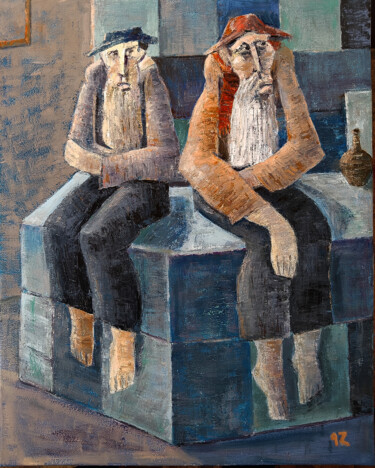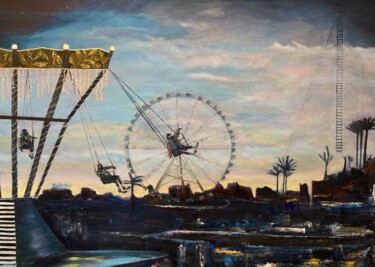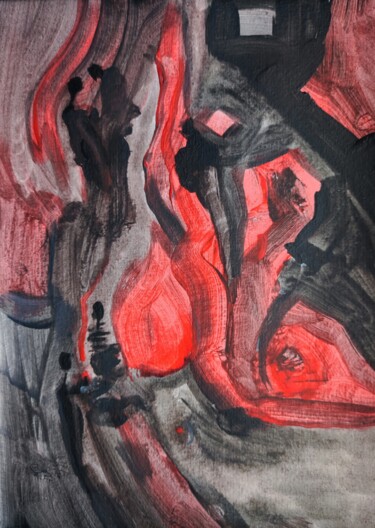13,095 판매용 원본 그림:
순수 예술 스타일를 어떻게 정의하나요?
What is a Naive painting?
Naive painting is a style of art that was started by artists like Henri Rousseau who didn't know much about art. Most of the time, naive art is defined as visual art made by someone who hasn't had the training and education that a professional artist does. When a professional artist tries to copy this style, it is often called "primitivism."
What are the characteristics of Naive painting?
Naive art is usually defined as visual art made by someone who doesn't have the formal training and education that a professional artist does (in anatomy, art history, technique, perspective, ways of seeing). When a trained artist tries to copy this style, it is sometimes called primitivism, pseudo-naive art, or faux naive art.
Unlike folk art, naive art doesn't have to come from a specific popular cultural context or tradition. In fact, at least in advanced economies and since the Printing Revolution, it's impossible not to know about the local fine art tradition, which has spread through popular prints and other media. Naive artists know about "fine art" conventions like graphical perspective and compositional conventions, but they can't or don't use them to their full potential. Outsider art (also called "art brut"), on the other hand, refers to works that come from a similar background but have little to do with the mainstream art world.
Naive art is known for being simple and honest like a child, and this is why it is often copied. These kinds of paintings usually have a flat style of drawing and a simple way of showing depth. Henri Rousseau, a French Post-Impressionist who lived from 1844 to 1910 and was discovered by Pablo Picasso, was one of the most important painters of "naive art."
There has been some disagreement about what the term means and where it "ends" with other terms like folk art and outsider art. Naive art is usually used to describe works of fine art made by self-taught artists, like paintings and sculptures. Folk art, on the other hand, refers to things that can be used in everyday life. But this difference has been argued about. [6] "Provincial" is another word that can be used, especially for paintings and buildings. It is mostly used to describe work by artists who have had some traditional training but whose work falls short of metropolitan or court standards by accident.
By what do naive paintings stand out?
People often think of naive art as art made by someone who hasn't had any formal training or a degree, or hasn't had much. Before the 20th century, this was true, but now there are schools for naive art. Naive art is now a fully recognized type of art that can be seen in galleries all over the world.
The features of naive art don't fit well with the formal aspects of painting, especially when the three rules of perspective aren't followed (as described by the Progressive Painters of the Renaissance):
-Objects get smaller as you get farther away,
-Colors become less clear as you get farther away;
-Details become less clear as you get farther away.
Here are the results:
-Geometrically wrong effects of perspective (awkward parts of the works, like how children's drawings or paintings from the Middle Ages look, but that's where the comparison ends);
-Effects of perspective that aren't quite right. Strong use of pattern, unrefined color on all the plans of the composition, without enfeeblement in the background;
-Equal attention to details, including those in the background that should be shaded off.
People say that naive art is easy to spot because it is not complicated. It has become so popular and well-known, though, that many examples could be called "pseudo-naive." "Pseudo naive" or "faux naive" art is the work of an artist who is more imitative or self-conscious and whose work looks more copied than original. "Naive" art is the work of an artist who did not go to art school or academy, like Henri Rousseau or Alfred Wallis.
Since Autodidactism has become more popular as a way to learn in modern times, strict naiveté is not likely to be found in modern artists. Living artists don't always like naive categorizations, but this is likely to change as more dignifying signals become known. There are now museums for naive art in Kecskemét, Hungary; Kovaica, Serbia; Riga, Latvia; Jaen, Spain; Rio de Janeiro, Brazil; Vicq, France; and Paris. Gary Bunt, Lyle Carbajal, Gabe Langholtz, Gigi Mills, Barbara Olsen, Paine Proffitt, and Alain Thomas are all English-speaking living artists who admit to having a naive style.
"Primitive art" is another term that people who haven't studied art often use to describe it. Historically, though, it has been used more to describe art from cultures that Western academia has deemed "primitive" socially or technologically, like Native American, sub-Saharan African, and Pacific Island art (see Tribal art). This is different from the "primitive"-inspired, self-aware movement called "primitivism." Folk art is another term that is similar to naive art but not the same thing.
There are also the terms "navism" and "primitivism," which are usually used to describe professional painters who use naive art as their style (like Paul Gauguin, Mikhail Larionov, Paul Klee).
What is the history of the Naive movement?
No one knows exactly when the first naive artists started making art, but from the very beginning of art to the time of the "Modern Classic," naive artists have left behind clear signs of their creative work. At the very least, naive art has been "official" in the history of 20th-century art since 1912, when an almanac called Der Blaue Reiter was published. Wassily Kandinsky and Franz Marc, who made the almanac, showed six copies of Henri Rousseau's paintings and talked about how they were different from other pictures. Most experts agree, though, that naive art was "discovered" in 1885, when the painter Paul Signac learned about Henri Rousseau's skills and started putting on shows of his work in some of the best galleries in Paris.
The Sacred Heart painters
Wilhelm Uhde, a German art collector and critic, is known for being the main person in charge of the first Naive Art show, which took place in Paris in 1928. Henri Rousseau, André Bauchant, Camille Bombois, Séraphine Louis, and Louis Vivin all took part. Together, they are known as the Sacred Heart painters.
Earth Group
The Earth Group (Grupa Zemlja) was a group of artists, architects, and thinkers from Croatia who lived and worked in Zagreb from 1929 to 1935. The group was Marxist and was partly based on "Neue Sachlichkeit,"[19] which led to more stylized forms and the start of Naive painting. In the group were painters Krsto Hegedui, Edo Kovaevi, Omer Mujadi, Kamilo Ruika, Ivan Tabakovi, and Oton Postrunik, sculptors Antun Augustini and Frano Krini, and the architect Drago Ibler. The Earth group tried to figure out how to solve social problems. Their program stressed the importance of creative freedom and was against blindly copying styles from other countries. They didn't want to make art just for the sake of art. Instead, they thought it should reflect the real world and the needs of the modern community. The government of the time was getting more and more upset by what was going on at the group's exhibitions, so in 1935, the group was banned.
Hlebine School
From about 1930 on, this term was used to describe naive Croatian painters who worked in or around the village of Hlebine, which is near the border with Hungary. At this time, the village was just "a few muddy, winding streets and one-story houses," according to the World Encyclopedia of Naive Art (1984). However, it produced such a great crop of artists that it became almost synonymous with Yugoslav naive painting.
Hlebine is a small, beautiful town in the north of Croatia. In the 1920s, a group of self-taught peasants started to paint in a way that was different and even a little bit revolutionary. Leading intellectuals of the time, like the poet Antun Gustav Mato and Miroslav Krlea, the most famous name in Croatian literature, pushed for this. They wanted a unique national style of art that was not influenced by the West. Krsto Hegedui, a well-known artist from Hlebine, took these ideas and used them to start the Hlebine School of Art in 1930. He did this to find "rural artistic expression" on a national level.
Ivan Generali was the first master of the Hlebine School. He was also the first artist to create a unique style and reach a high level of art. After the Second World War, the next generation of Hlebine painters focused more on stylized, made-up pictures of life in the country. Generali stayed the most important person and helped other artists, including his son Josip Generali, get started. With the 1952 Venice Biennale and shows in Brazil and Belgium, the Hlebine school became known all over the world.
Some of the best known naive artists are Dragan Gaži, Ivan Generalić, Josip Generalić, Krsto Hegedušić, Mijo Kovačić, Ivan Lacković-Croata, Franjo Mraz, Ivan Večenaj and Mirko Virius.
What are some famous Naive paintings?
Naive art is made up of simple, childlike techniques and ideas. Because of this, modernists who don't like what they see as the fake sophistication of work made in the traditional system have praised it. Henri Rousseau is the best-known naive artist working today, so we'll start with one of his works.
The Dream (1910) by Henri Rousseau
The young girl has been taken to a jungle, where a local musician plays a brass instrument and sings to her. Yadwigha, who is half hidden by the jungle's shadows, reaches out to the musician while looking out over a beautiful view of jungle greenery with lotus petals, parrots, monkeys, an elephant, two lions, and a snake. The snake coming toward the scene in the lower right corner of the picture makes me think of the Garden of Eden. A pink snake moves through the bushes. Its shape, which is like a snake, looks like a woman's legs and hips.
In this piece of art, a naked model is sitting on a sofa, which brings together the familiar and the strange. The painting "The Dream" shows why the Surrealists liked Rousseau's work. It has amazing attention to detail, bright colors, and a strange mix of images.
At least 22 different shades of green were used to paint the jungle plants. Poet and art critic Guillaume Apollinaire was blown away by the work. "The painting is absolutely gorgeous!" he exclaimed. I don't think anyone will laugh this year."
This picture looks like a dream because the only thing in it is a naked woman lying on a sofa in the tropics. But it's not clear if the art shows Yadwigha's dream or Rousseau's. But one of the best things about the picture is how open it is to different interpretations. Rousseau's trips to the natural history museum and the Jardin des Plantes in Paris gave him ideas for this piece, which has a lush jungle, wild animals, and a mysterious horn player. "When I'm in these hothouses and see strange plants from other places, it feels like I'm entering a dream," the artist said of his visits.
Death ship (1942) by Alfred Wallis
The main idea behind Alfred Wallis's Death Ship is a huge black ship with dark gray steam billowing from it. Five sailors in black suits and caps can be seen as the ship moves over icy white water. This picture, which has a good name, is a great example of the kind of work Wallis did in his later years. They show how sad the artist was feeling at the time.
Wallis made these paintings while he was alone and his eyesight was getting worse and his mind was getting worse. No one knows for sure when Wallis finished making these last changes. They were made either while Wallis was living in the Madron poorhouse or just before he was sent there, which was something he had been afraid of for a long time. Death Ship disproves the idea that Wallis couldn't use deep and complicated symbolism in his work because he was a "naive" artist. The ship is a sign of death and destruction, which is more of a metaphor than a literal representation of the things Wallis paints. It is a mix of the feelings Wallis had when he was at sea and when he was near the coast of St. Ives.
The Broken Column (1944) by Frida Kahlo
After she was badly hurt in a car accident when she was 18, most of Frida Kahlo's self-portraits are about her physical and mental pain. As her health got worse, this theme came back and got much stronger as her life came to an end. Her graphic pictures of herself in pain show how hard it was for her to deal with physical problems and pain. "The Broken Column," a painting by Kahlo, was made soon after she had surgery on her back.
This was just one of many times she had to go to the doctor to fix problems caused by an injury she had in the past. Kahlo had to wear a steel corset while painting, which was different from the plaster casts she had worn before. In the picture, Kahlo is standing in a broken, empty place that looks like it has been through as much trouble and tragedy as she has. Due to a deep, jagged crack that runs the length of her almost-naked body, her spine looks like a broken Ionic stone column. Her spinal column looks like it's about to break, especially at the bottom. Nails of different sizes go through her whole body and face, making her pain even worse. She has a lot of tears running down her cheeks.
Kahlo painted herself naked at first, except for the medical support girdle she wears. Then she added a white covering that looks like it came from a hospital to cover her bottom half. Her breasts are showing, and even though her body has been cut up, her sensuality shines through. The way nails and sheets are shown also has strong echoes of the Christian symbol of martyrdom. Even though she is in pain, Kahlo's face shows that she is strong and will not give up. Even though her body has been hurt and tortured, it is clear that her spirit has not been hurt.
This is the end of our look at Naive art, a style that looks simple and childlike. This word is used to describe paintings made in cultures that are more or less advanced but don't have the traditional skills to draw things. The colors are bright and not natural, the view isn't scientific, and the meaning is literal or childish.
판매용 원본 그림을(를) 찾고 계십니까?
현대 회화, 거리 예술, 추상 예술, 구상 예술, 풍경, 초상화, 정물, 누드, 수채화, 유화, 아크릴 페인팅 등 모든 스타일과 모든 회화 기법을 탐색합니다. 360만 개 이상의 현대 미술 작품을 발견하거나 획득할 수 있는 20년 동안 당신의 편입니다! 현대 회화의 관점에서 세계 참조. 전 세계의 현대 작가들의 작품을 찾아 품격 있는 인테리어를 완성해보세요! 단순한 예술 애호가 또는 확인된 수집가? 장식을 진정으로 향상시킬 좋아하는 캔버스 또는 그림을 찾으십시오. ArtMajeur는 세계 최고의 현대 예술가들의 독창적인 작품, 한정판 및 예술 판화를 제공합니다. ArtMajeur에서 그림은 예술 시장 애호가와 전문가에 의해 선택됩니다. 최신 유행의 수상 경력에 빛나는 유명 화가와 현대 미술 분야의 새로운 떠오르는 스타의 원본 작품을 선택하여 온라인으로 그림을 구매하는 과정을 안내하고 도와드립니다.
ArtMajeur에서 현대 원시 미술 작품을 발견하세요
현대적인 순진 예술 회화는 전 세계의 예술 애호가와 수집가들 사이에서 인기를 얻고 있습니다. 이러한 독특하고 독창적인 작품들은 예술 교육을 받지 않은 자습 예술가들이 만들어 낸 것입니다. 그들은 캔버스, 나무, 종이, 때로는 재활용 재료 등 다양한 지지체와 재료들을 사용합니다. 예술가들은 밝은 색상, 짙은 선, 간단한 모양을 사용하여 그들의 작품을 만들어 내며, 그것은 유아적이고 원시적인 스타일로 특징지어집니다.
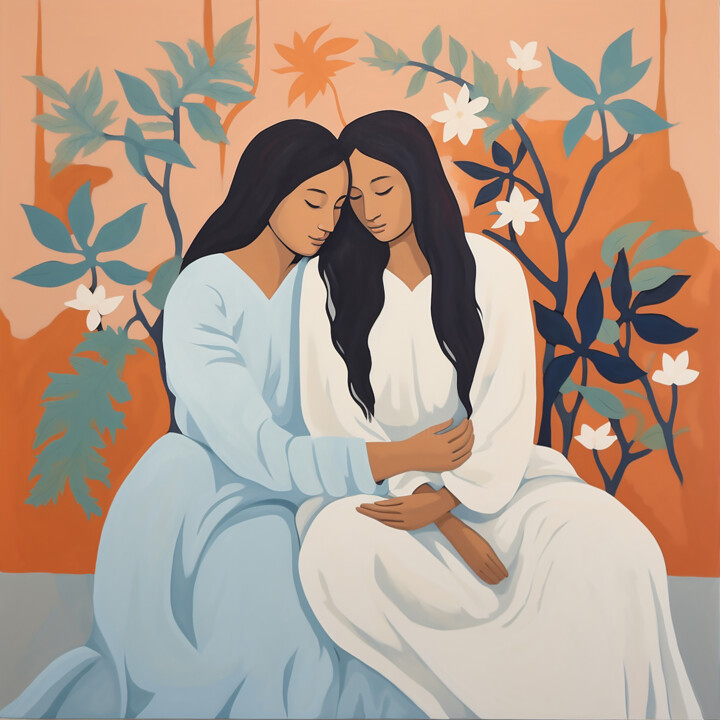
©2025 Kosta Morr
기원과 역사
현대의 순진한 예술 그림은 아웃사이더 아트 또는 아르 브뤼트로도 알려져 있으며, 전통적인 학술 예술에 대한 반응으로 20세기 초에 발생했습니다.
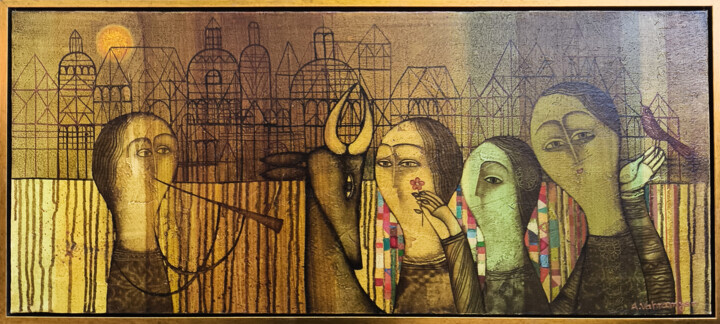
©2025 Armen Vahramyan Narinart Armgallery이(가) 대표하는 아티스트
현대 미술 시장에서 이 작품들의 진화
현대 순진미술 회화는 작가들이 새로운 기술과 스타일을 탐구하기 시작함에 따라 최근 몇 년간 진화를 거쳤습니다. 이러한 작품들은 종종 화려한 색상, 대담한 선들과 어린아이같은 경이로움을 띠고 있어서, 향수와 순수함의 감성을 자아냅니다. 이로 인해, 이러한 회화는 독특하고 표현력이 뛰어난 작품들을 찾는 수집가들과 애호가들 사이에서 점점 더 인기를 얻고 있습니다. 일부 작가들은 자신들의 작품에 사회나 정치적 코멘트의 요소를 더해, 그들의 창조물에 더 깊은 의미와 관련성을 부여하기도 합니다. 전반적으로, 현대 순진미술 회화의 진화는 현대 미술의 다양성과 창의성을 반영하며, 끊임없이 변화하는 미술 세계에서 새로운 아이디어와 기술을 수용하는 것의 중요성을 강조합니다.
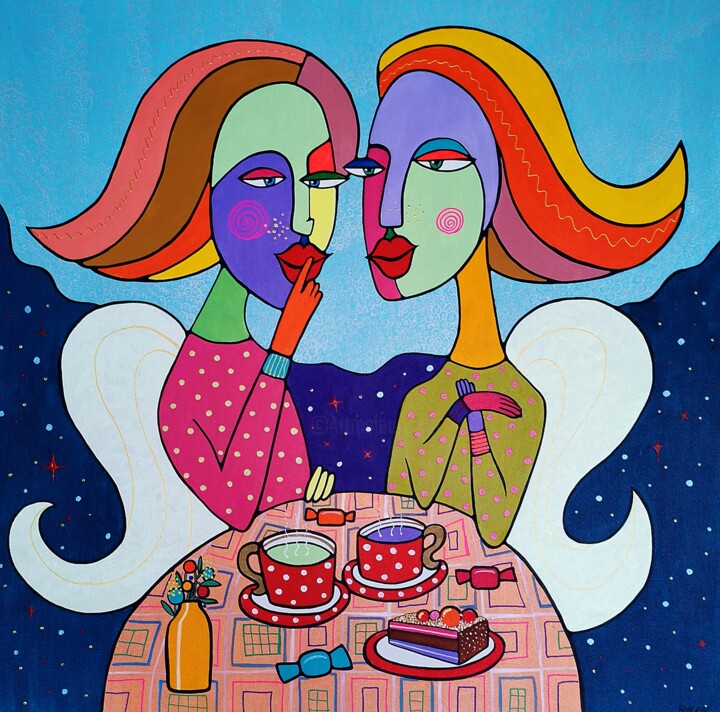
©2025 Daheaven Art
관련 유명 예술가
현대 나이브 아트 작품으로 유명한 작가들은 원시주의 작가들, 아웃사이더 작가들, 민간 예술 화가들, 그리고 스스로 배운 작가들이 포함됩니다.
제임스 캐슬은 그들 중 하나로, 발견된 물건을 이용해 그림, 회화, 구조물을 만들어 독특한 세계를 창조한 자학적 예술가입니다. 캐슬의 예술은 자료의 감정적 표현과 일상 생활의 아름다움을 담아내는 능력으로 잘 알려져 있습니다.
또 다른 주목할 만한 예술가는 76세에 그림을 그리기 시작한 Grandma Moses입니다. 그녀는 시골 생활을 묘사한 그림으로 국제적인 인기를 얻었습니다. 그녀의 예술은 간단한 형태, 대담한 색상, 그리고 매력적인 이야기로 특징지어집니다.
장 미셸 바스키아는 인종, 정체성 및 권력과 같은 주제를 탐구하기 위해 원시적이고 표현적인 스타일을 사용한 아웃사이더 예술가입니다. 그의 그림들은 종종 대담하고 그래픽적인 이미지와 텍스트를 특징으로 하며, 그는 미국의 흑인 예술가로서의 경험을 반영합니다.
마침내, 헨리 다저는 회귀주의 예술가로, 그림, 그림 그리기 및 글쓰기를 통해 서사시적인 서사시를 창조했습니다. 그의 작품은 종종 악한 세력과의 대규모 전투에 참여하는 어린아이 같은 캐릭터들이 살고 있는 환상적인 세계를 묘사합니다.
이들 예술가들은 니브 미술 회화에 다양한 스타일과 접근 방식을 대표하지만, 모두 예술의 매체를 통해 자신만의 시각을 표현하는데 헌신하고 있습니다.

©2025 Елизавета Пугачева
현대 나이브 미술 작품
현대 우주 미술 그림은 그들의 단순하면서 매력적인 성격으로 인해 최근에 큰 인기를 얻었습니다. 여기 몇 가지 잘 알려진 예술 작품과 간단한 설명이 있습니다:
"The Hug" by Jivya Soma Mashe (2007)은 어머니와 아이 사이의 따뜻한 순간을 밝은 색상과 대담한 선으로 그린 작품입니다.
"The Village" by Séraphine Louis (1928)은 복잡한 세부사항과 패턴으로 가득한 다채로운 마을 풍경을 그린 작품으로, 작가의 자연에 대한 애정을 반영합니다.
"The Dream" by Grandma Moses (1945)은 아이 같은 스타일로 그린 마을, 교회, 강 등이 등장하는 꿈 같은 장면을 그린 환상적인 작품입니다.
"The Wedding" by Nikifor Krynicki (1968)은 복잡한 세부사항과 생동감 넘치는 색상으로 전통적인 폴란드 마을에서 열리는 화려한 결혼식을 그린 작품입니다.
"The Sunflowers" by Henri Rousseau (1909)은 정글 속에서 피는 해바라기들을 아이 같은 순수함과 경이로움으로 그린 아름다운 걸작입니다.
전반적으로, 현대적인 순진미술 작품은 단순함, 매력, 생생한 색감을 통해 세상에 대한 독특한 시각을 제공합니다.
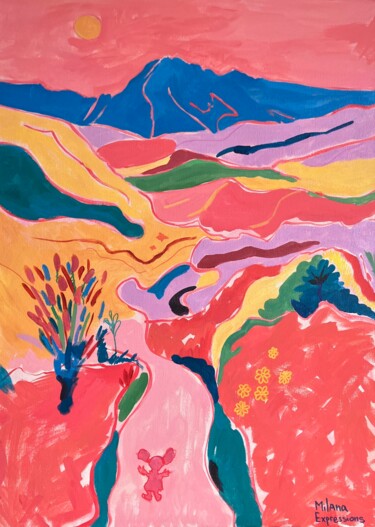
Milana Chtch
캔버스의 아크릴 | 27.6x19.7 in

Milana Chtch
캔버스의 아크릴 | 27.6x19.7 in

Claudio Mario Andrea
캔버스의 아크릴 | 19.7x19.7 in

Armen Vahramyan
캔버스의 기름 | 11.8x27.6 in

Claudio Mario Andrea
캔버스의 아크릴 | 39.4x43.3 in
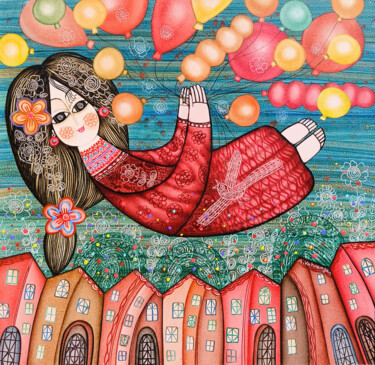
Armen Vahramyan
캔버스의 기름 | 19.7x19.7 in

Daheaven Art
캔버스의 아크릴 | 35.4x35.4 in

Milana Chtch
캔버스의 아크릴 | 23.6x39.4 in

Jsroosenys
캔버스의 아크릴 | 21.7x18.1 in

Claudio Mario Andrea
캔버스의 아크릴 | 59.1x59.1 in
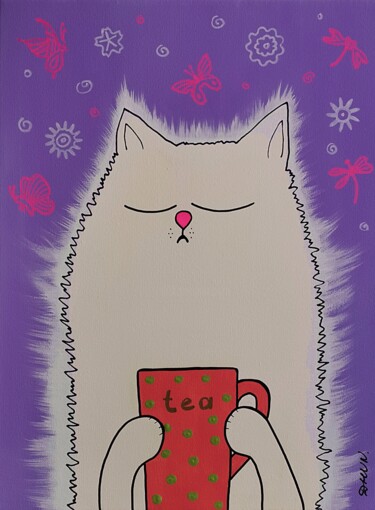
Daheaven Art
캔버스의 아크릴 | 15.8x11.8 in
